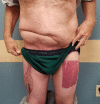Incisions and reconstruction approaches for large sarcomas
- PMID: 30505973
- PMCID: PMC6232070
- DOI: 10.21037/tgh.2018.10.07
Incisions and reconstruction approaches for large sarcomas
Abstract
Large intraabdominal, retroperitoneal, and abdominal wall sarcomas provide unique challenges in treatment due to their variable histology, potential considerable size at the time of diagnosis, and the ability to invade into critical structures. Historically, some of these tumors were considered inoperable if surgical access was limited or the consequential defect was unable to be closed primarily as reconstructive options were limited. Over time, there has been a greater understanding of the abdominal wall anatomy and mechanics, which has resulted in the development of new techniques to allow for sound oncologic resections and viable, durable options for abdominal wall reconstruction. Currently, intra-operative positioning and employment of a variety of abdominal and posterior trunk incisions have made more intraabdominal and retroperitoneal tumors accessible. Primary involvement or direct invasion of tumor into the abdominal wall is no longer prohibitive as utilization of advanced hernia repair techniques along with the application of vascularized tissue transfer have been shown to have the ability to repair large area defects involving multiple quadrants of the abdominal wall. Both local and distant free tissue transfer may be incorporated, depending on the size and location of the area needing reconstruction and what residual structures are remaining surrounding the resection bed. There is an emphasis on selecting the techniques that will be associated with the least amount of morbidity yet will restore and provide the appropriate structure and function necessary for the trunk. This review article summarizes both initial surgical incisional planning for the oncologic resection and a variety of repair options for the abdominal wall spanning the reconstructive ladder.
Keywords: Sarcoma; abdominal wall; abdominal wall reconstruction; intra-abdominal; retroperitoneal.
Conflict of interest statement
Conflicts of Interest: The authors have no conflicts of interest to declare.
Figures












References
Publication types
LinkOut - more resources
Full Text Sources
